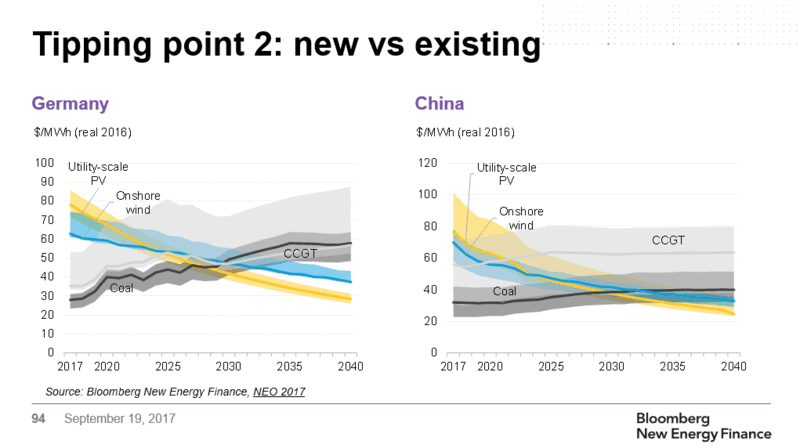With new technologies hitting the markets every day, renewables are becoming cheaper far faster than anyone anticipated. This trend puts clean energy in investors’ cross-hairs and spells the end of coal as the mainstay of power grids around the world.

Michael Liebreich, founder of the Bloomberg New Energy Finance (BNEF), says clean energy will take the cream of future investments, leaving fossil fuels in the dust. In a presentation he held at the research group’s conference this Tuesday in London, Liebreich said emerging tech is making clean energy more economical than fossil fuels for utilities in many countries around the world. In light of this trend, he estimates that the clean energy sector will attract 86% of the $10.2 trillion likely to be invested in power generation by 2040.
BNEF first took shape as New Energy Finance, a data company focused on energy investment and carbon markets research based in the United Kingdom and was purchased by Bloomberg L.P. back in 2009. When the company first began collecting data in 2004, it could already spot a trend towards larger machines and installations in the wind energy sector, all designed to deliver more power to the grid. A trend that is continuing even today, with both Siemens and Vestas Wind Systems working on plans for huge turbines, with wingspans larger than that of the world’s biggest aircraft, the Airbus A380.
This trend also carries with it the promise of even greater cost-efficiency, so much so that offshore wind developers in Germany are promising electricity without subsidy for their upcoming projects.
“One of the reasons those offshore wind costs have come down to be competitive without subsidies is because these turbines are absolute monsters,” Liebreich said. “Imagine a turbine with a tip height that’s higher than The Shard.’’
The cost per unit of energy from photovoltaic solar panels is also continuing to drop, making them more and more competitive against fossil fuels. That’s why Liebreich predicts two “tipping points” in the future, which will make fossil-fuel-generated power increasingly unattractive from an economic point of view.
“The first is when new wind and solar become cheaper than anything else,” Liebreich said.
“At that point, anything you have to retire is likely to be replaced by wind and solar,” he added. “That tipping point is either here or almost here everywhere in the world.”

These tipping points won’t happen everywhere at the same time, and their exact dates aren’t set in stone; it’s a process. A slide from Liebreich’s presentation, however, shows we could expect Japan to reach this milestone (i.e. building a PV plant will become cheaper than building a coal-fired generator) in 2025, while India will pass it by 2030, but for wind power.
Further down the road, the second tipping point will come when running costs for coal or gas plants become higher than those of solar or wind. According to this chart published by BNEF, that point may arrive sometime in the middle of the next decade in both Germany and China.

Energy prices vary quite considerably from country to country, so it’s difficult to make a precise estimation of when renewables will overtake fossil fuels in supplying power grids. Still, Liebreich is convinced that the economics of solar and wind are becoming attractive enough to overtake coal’s dominant position in the global power equation, no matter what incentives President Trump imposes on the US.
“This is going to happen,” Liebreich said, reffering to the transition to clean enery. “Coal is declining in the US. Nobody is going to make coal great again.”


